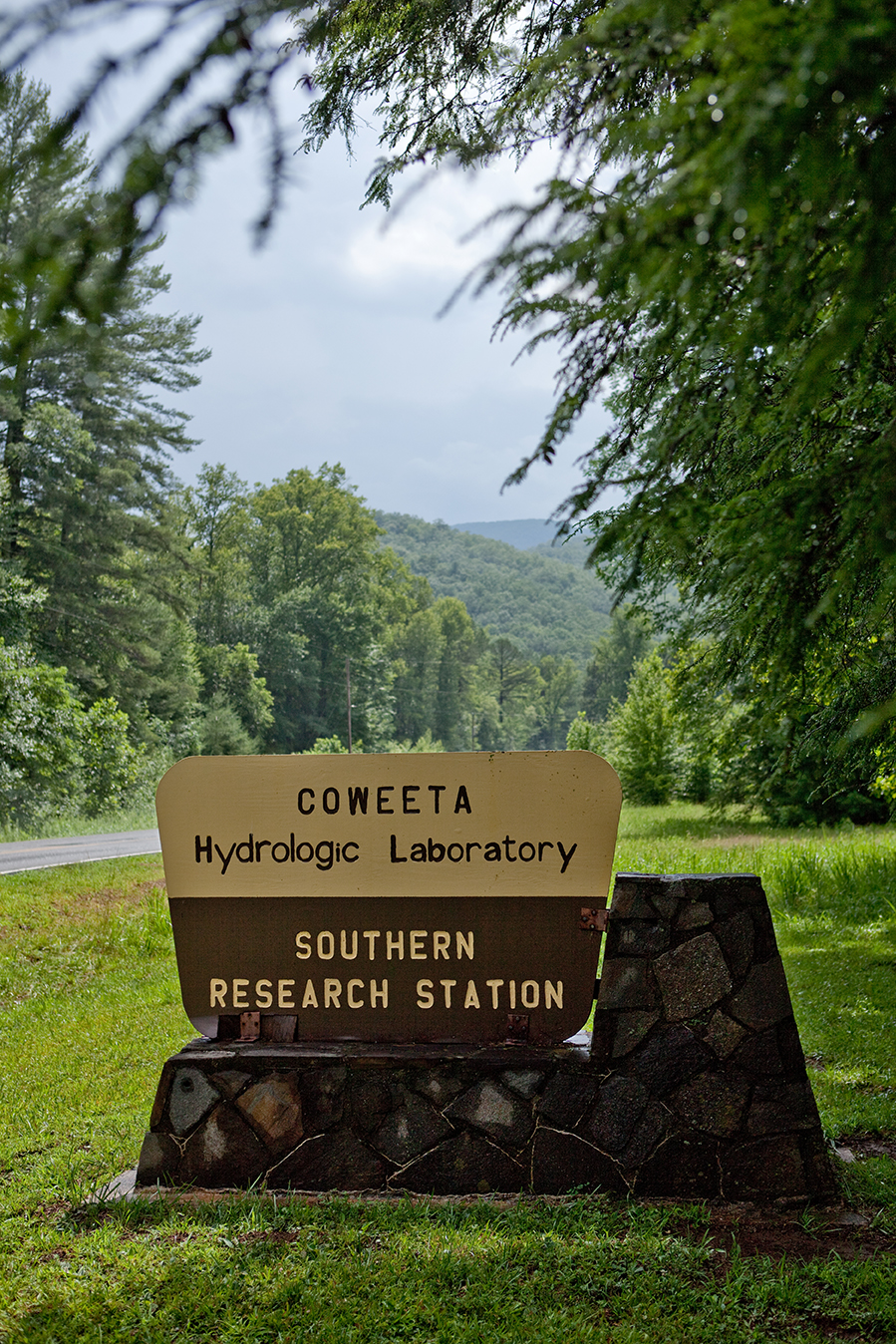Taking Mother Nature’s Pulse
By: Cynthia Adams | Photos By: Nancy Evelyn
Chelcy Ford knows ecosystems and is monitoring their vital signs: They breathe, pulse, and yes, respond just like you and me. What led Ford to an isolated pocket in the North Carolina Highlands where it rains six feet in a year? And what was she up to in Washington?
AN INTERVIEW WITH CHELCY FORD
Ford earned a PhD at UGA in Forest Resources in 2004. She also has degrees in botany and applied biology. This scientist now works at the Southern Research Station at the Center for Forest Watershed Science at Coweeta Hydrologic Laboratory in the Appalachian Mountains.
Ford explains that the Center is charged with evaluating, explaining, and predicting how water, soil, forest, and aquatic resources respond to ecosystem management practices, natural disturbances, and the atmospheric environment; and identifying practices that restore, protect, and enhance watershed health. The researchers conduct long-term hydrologic and ecological research on forested upland and wetland watersheds.
The National Science Foundation sponsors the UGA-led Coweeta Long-Term Ecological Research project. The other lead institution on the grant is the USDA Forest Service. In addition to the University of Georgia, participating institutions involved in the Coweeta research group include Duke, UNC-Chapel Hill, UNC-Charlotte, NC State University, the Virginia Polytechnic Institute, Mars Hill College, Yale, and the Universities of Illinois, Minnesota and Wisconsin.
As a scientist, Ford uses the words “climate change” with authority. It is her business to be objective and analytical, and it gets on her last nerve when she hears naysayers insist “climate change” is a manipulative, misleading phrase.
She knows whereof she speaks. Ford was tapped by the federal government to join a consortium of scientists for an extended, ongoing research project. The expert team convenes in a building on Pennsylvania Avenue in Washington, D.C. Even though she’ll physically leave the project in January, 2012, Ford says she’ll “continue to work on the project from Coweeta until June 2012.
“At that point, the Federal Advisory Committee will take over and work on it until 2013.” Ford has been coordinating with other scientist across the U.S., synthesizing data and making critical recommendations for the future.
Lindsay Boring is director of the Joseph W. Jones Ecological Research Center/Ichauway in Newton, Ga. Ichauway is a 29,000-acre conservation site, bequeathed by the Robert W. Woodruff Foundation to the Jones Center. More than 25 graduate students work at the Jones Center and Ichauway. Boring met Ford when she was a UGA student at the Jones Center. He says she is “a rising star whose star has been rising” among a field of impressive researchers. “She is bright, thoughtful, methodical,” he says. “Chelcy shows an amazing amount of maturity.”
Their experiences share parallels: Boring worked in Coweeta for 20 years prior to coming to Newton. Ford says she drew inspiration from Boring. “I have nothing but respect and accolades for him. I don’t know of many people who have the passion that he has for his job…and I am so grateful for the opportunity I had to do research in and live in the beautiful and ecologically diverse longleaf pine woodlands at Ichauway. In some respects, I feel that Lindsay and I have a very common thread to our careers, only in reverse. He started at UGA, went to Coweeta, and then went to the Jones Center; whereas I started at UGA and the Jones Center and ended up at Coweeta.”

Coweeta Hydrologic Lab area
The center is charged with evaluating, explaining, and predicting how water, soil, forest, and aquatic resources respond to ecosystem management practices, natural disturbances, and the atmospheric environment; and identifying practices that restore, protect, and enhance watershed health.
Ford presently works with the Coweeta station and Washington office science delivery groups, communicating research results to the public through press releases, correspondence and interviews. She provides information through adaptive management experiments, field demonstrations, tours, formal consultations and informal discussions.
“Ford is a rising star whose star has been rising ,” says Lindsay Boring, Director of the Joseph W. Jones Ecological Research Center/Ichauway in Newton, Ga. Ichauway is a 29,000-acre conservation site, bequeathed by the Robert W. Woodruff Foundation to the Jones Center.

Chelcy Ford at water weirs and at research stations. Coweeta Hydrologic Lab.
Graduate School Magazine: You’ve a varied background. What inspired you to become a scientist?
Ford: Interestingly, I wasn’t a very good student when I was young. I just wasn’t interested in school. That all changed in the sixth grade; in sixth grade I was first exposed to science. And, it was like a light bulb went off. Learning suddenly had a structure (the scientific method) and a defined and crucial place for inquisitiveness. Before I was exposed to science in school, I was an average student… I wasn’t really engaged. In the sixth grade, everything turned around; and, I know that a large part of that transition was science. I’ve also had some really inspiring science teachers throughout my education. In short, I’ve always been interested in science… and, well, I just kept doing what I enjoyed.
Graduate School Magazine: What is the ultimate job for you—what do you aspire to?
Ford: This is going to sound rote, or maybe shortsighted, but the job I have is the one I’ve always wanted. And, I’ve worked hard to get here. I’ve never wanted a career in academia. I’ve always wanted to be a scientist in a federal or state agency. I want to conduct basic science, but always find an application for that science that is useful to society. The Forest Service has this vision at the heart of their mission statement. And, I wholeheartedly believe in the mission of the Forest Service—in caring for the land we are serving the people.
Graduate School Magazine: How did you get tapped to work for the Global Change Research Program?
Ford: The US Global Change Research Program (USGCRP) was tasked with the effort of providing a report on climate change in the U.S., the National Climate Assessment (NCA) report, to Congress no less frequently than every four years by the 1990 Global Change Research Act. To this end, all of the 13 federal agencies that conduct science must participate in this effort, typically by synthesizing their own science in the form of technical input products. When the USGCRP asked the USDA Forest Service for participation, both the project leader of Coweeta and I were proffered as scientists who would participate and help the USGCRP with the 2013 National Climate Assessment.
Graduate School Magazine: What role will you play in Washington during this assignment (in organizing a mass of data and research)?
Ford: My role will mainly be in facilitating the process. Federal agencies aren’t the only ones who will be able to produce technical input products that could be considered for inclusion in the 2013 NCA. A request for information recently was released by the USGCRP soliciting input from anyone who was interested in participating. This means that monitoring networks, private institutions, and any other group or individual could produce a technical input product.
Most importantly to the process, is that the information must be vetted and peer reviewed, and that all technical input products must be vetted and delivered by March 1, 2012 to be considered for inclusion in the NCA. In short, there are a lot of moving parts, and my role, in part, will be to facilitate this process.
Graduate School Magazine: Who will receive these data and the final report in 2013—and will the general public also have access?
Ford: After all technical input products are received on March 1, 2012, a federal advisory committee will begin crafting the NCA using all the products. The federal advisory committee will deliver the NCA to Congress shortly thereafter. The NCA will also be readily accessible to the public, similar to the Intergovernmental Panel on Climate Change (IPCC) reports.
Graduate School Magazine: Are detractors correct—is “global warming” a misleading term? Is that why everyone’s now using the moniker “climate change?”
Ford: I think the term “global warming” is in no way misleading. As we pump more greenhouse gasses into the atmosphere, the surface of the Earth will increase in temperature. That being said, the term “climate change” is a much more inclusive term. For example, the human population is increasing (we’ll hit seven billion this year); at the same time, we know that with global warming, the frequency of extreme events will increase. This means that the future will likely be a place with more humans, increased temperatures, and more hurricanes, tornados, floods, etc.
Graduate School Magazine: What do you think must shift in public perception concerning climate change?
Ford: I think a few things must change before we start making real progress towards addressing the effects of climate change—foremost is the public’s perception. The Yale University Project on Climate Change Communication released the results of a poll this past spring that showed that only two-thirds of people thought climate change was occurring. Of those two-thirds, only half of those people think it is human-caused. Perhaps the most interesting finding was that most people thought scientists were more skeptical of climate change than they actually are. Only 13% of the people actually knew that 81–100% of scientists think that climate change is happening. Almost a quarter of the respondents thought that scientists were split 50–50 on the issue. One explanation for the discrepancy is that most people learn about climate change from the media; and the media displays a much more conflicted view of climate change than what actually exists in the scientific community.
Graduate School Magazine: Surrounded by the famously natural and lush beauty of the Appalachians, how does this setting frame your own scientific thought/approach, or does it?
Ford: The southern Appalachians are beautiful, but honestly I try not to let the ecosystem frame the thought and approach to my science. My approach instead is to frame the questions and then find a model system in which to test the questions. Because most of my work involves forest water relations, sometimes the southern Appalachians serve as a model system (we get over two meters, roughly six feet of rainfall per year here!); but sometimes, a more water-limited system serves as a better model. This is why a good portion of my past and current work occurs in the longleaf pine savanna systems of southwest Georgia. I have active ongoing collaborations with scientists at the Joseph W. Jones Ecological Research Center in southwest Georgia.
Graduate School Magazine: Finally, what is it like to have to work with a bunch of Tar Heels on the wrong side of the Georgia border?
Ford: Ahh, you know most of the scientists at Coweeta aren’t from North Carolina! So, I don’t necessarily work with a bunch of Tar Heels. Currently our scientists here are from Missouri, Arizona, California, Illinois, Maryland and Virginia. The bigger issue for me is going home on holidays. Both my husband and I graduated from Georgia Tech, as did my brother-in-law. And, my family is a die-hard supporter of Tech. They weren’t too keen on me going to UGA for my doctorate, although they have one of the best forest science programs in the nation. So Thanksgiving, when UGA plays Tech in football, is always a time of conflicting allegiances in my family!
Graduate School Magazine: How do you recharge your creativity?
Ford: First, I like to hike. My husband and I take long-distance hiking vacations every few years. We hiked across England in 2005. We hiked 200 miles from the Irish Sea to the North Sea. Second, I do a lot of personal reading. I read about 40-50 books a year. One of my favorite books is Red Mars. Describing how that planet could be terraformed is truly inspiring.

Chelcy Ford in the greenhouse at Coweeta Hydrologic Lab area
Are we warm? Or merely very uncomfortable? News pundits keep us wondering.
“Where Did Global Warming Go?” The New York Times asked last fall. They reported “even as other countries take action, the issue is fading from the American agenda,” and stated, “America lags as India and China pursue aggressive steps on climate.”
The article cited Andrew J. Hoffman, director of the University of Michigan’s Erb Institute for Sustainable Development. Hoffman said, “In Washington, ‘climate change’ has become a lightning rod, it’s a four-letter word.”
The Times included a Pew Research poll on the subject of climate change. “The number of Americans who believe the Earth is warming dropped to 59 percent last year from 79 percent in 2006,” they stated.
Merely two weeks later, on October 31, 2011, the Associated Press published the findings of California physicist and skeptic Richard Muller. Muller, who has challenged the veracity of climate change, has recanted. He examined the Earth’s temperatures over the past 200 years, and now concurs that temperatures are rising and that climate change is real.
“Honestly, I try to avoid all news outlets on the TV,” Chelcy Ford replies in response. “I mainly get my ‘popular news’ from listening to National Public Radio’s ‘Morning Edition.’ Other than that, I have a few blogs that I read and a few podcasts that I routinely listen to; and, of course, I routinely read several of the main scientific journals in my field.”
IN MY OWN WORDS
Water lost through plant leaves and off plant and soil surfaces, called evapotranspiration, or ET, makes up half of the water lost from most terrestrial vegetated ecosystems. Because ET comprises such a large component of the water cycle, accurate estimates of ET in managed and unmanaged ecosystems are critical to interpreting the effects of management, natural disturbances, and climate change on water resources such as stream flow.
In addition, forest productivity and growth are inextricably linked to the loss of large quantities of water as vapor through transpiration. The ratio of water loss to productivity varies, but forest trees typically lose 170 to 340 kg of water vapor for every kg of biomass accumulated. The efficiency of production (i.e., kg dry mass produced kg-1 water vapor lost) can be a useful index because it relates to water resources and carbon sequestration; however, accounting for the total water lost by a tree over its lifetime is not easily accomplished, whereas measuring the resulting biomass is.
While studies that focus on stream flow from watersheds with different land uses can provide fundamental information regarding how forest development and land-use affect ET, these studies capture a picture of water lost from plant and soil surfaces, processes which are not easily separated. Several water cycle models incorporate water loss from these varied surfaces on stream flow generation, but many were originally derived for crops or simple forest systems and have proven difficult to apply to forests with complex structure and diverse species assemblages.
Forest structure and species composition change as forests age, undergo development, management, disturbance, and experience and respond to climate. Understanding the factors that control water loss through only forest trees and in turn how they affect stream flow requires detailed knowledge of water flow within a tree (i.e., sap flow) and how this flow responds to the climate around the leaf. Tree-based measurements of xylem sap flow allow us to evaluate and scale tree water loss so that we can see how stream flow responds to changes in forest structure, forest special composition, and tree size and age.
Being able to resolve the importance of species identity on the water cycle is challenging, but critical for addressing questions of management, natural disturbances, and climate change on stream flow. Management and natural disturbances often create forests with specific species or structure. Climate change will have a similar effect. Because the average rate at which ecosystems must shift geographically to keep pace with changing temperatures as a result of global warming is 0.42 km/year, most ecosystems will face temperature increases faster than species will be able to migrate or adapt, leading to mass extinction of many plant species. Thus, developing an understanding of species-level variation on forest processes will allow us to predict the impacts of invasive insects (e.g., hemlock woolly adelgid) and disease (e.g., chestnut blight), climate change (i.e., by linking stress physiology with population dynamics), and develop management options to adapt to or mitigate the impacts on stream flow.
Untangling this high level of complexity requires knowledge from many disciplines. As such, my personal research is focused on elucidating ecophysiological mechanisms and controls on carbon and water cycling in managed and unmanaged forest ecosystems at multiple scales. My primary areas of emphasis are: (1) quantifying rates of and driving mechanisms influencing water and carbon fluxes in trees across a range of environmental conditions; and (2) scaling these measurements in time and space, often in a predictive manner, to make inferences on forest ecosystem processes (e.g., stream flow and forest productivity) under changing management or climatic conditions.
-Chelcy Ford








